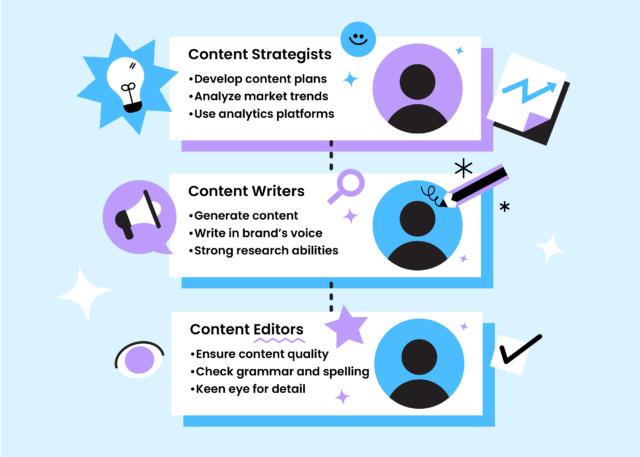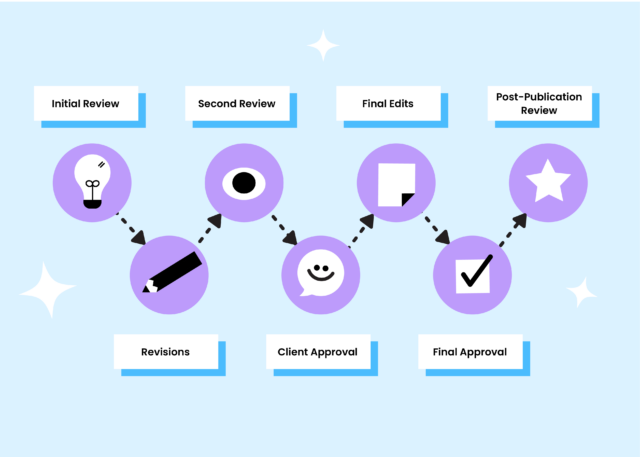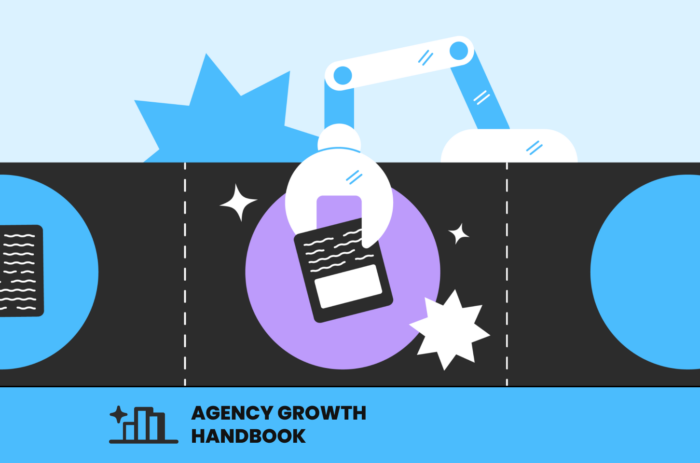This article is from our Agency Growth Handbook—a collection of guides created to help local SEO agencies grow and succeed. It is chapter one of ‘Part Two: Processes and Workflows‘.
The world of content marketing is changing at what feels like the speed of light. When you think you have figured out how to scale your content needs, a new AI tool or Google algorithm update arrives to throw a wrench in your workflow. While that’s one of the many things that makes our field exciting and dynamic, it continues to show us we’re not just writing for humans; we’re also navigating Google’s algorithms and adapting to AI advancements.
Content marketing is a key part of a digital agency’s offering. This guide is designed to help you balance the constant changes while scaling your content output. It’s also valuable for in-house marketers managing content to help promote multiple locations.
From dominating local search results to crafting content that deeply connects with your audience, this guide provides resources for scaling up content production without compromising quality. It offers insights that can help you evaluate agency performance, set realistic expectations, and understand what high-quality, localized content looks like.
Ready to improve your content strategy and drive business growth? Let’s begin.
Setting Up Effective Content Workflows and Processes
Creating content consistently and at scale is a challenge, especially for busy marketing teams, no matter how big or small your clients—or their budgets—are. As an agency with standard operating procedures (SOPs) and workflows, you should already have some content processes ironed out.
Before we explore how to improve your workflows and processes, we recommend reviewing your content processes regularly to ensure we’re efficient in delivering quality content. Think of these tips below as a review of your processes. Consider each one and ask yourself: Does our current process, or the process we hope to build, account for this step in the content workflow?
Defining Clear Objectives and Goals for Content
Clear goals keep content projects on track. SMART goals (Specific, Measurable, Achievable, Relevant, Time-bound) give you a solid plan to follow. They help you focus your efforts and see if you’re making progress.
For instance, a SMART goal might be to increase organic traffic to a client’s website by 20% over six months by publishing three optimized blog posts weekly. Here’s how to break this down:
| Specific | Define the exact outcome you want. Example: Increase organic traffic by 20%. |
| Measurable | Determine how you will measure success. Example: Use Google Analytics to track traffic. |
| Achievable | Ensure the goal is realistic. For example, a 20% increase is ambitious but possible based on past performance. |
| Relevant | Align the goal with broader business objectives. Example: Increasing traffic supports the goal of higher online sales. |
| Time-bound | Set a deadline. Example: Achieve this increase within six months. |
Aligning content objectives with broader client goals ensures that every piece of content contributes to our client’s overall growth strategy. This might involve increasing brand awareness, generating leads, or improving customer retention.
For example, suppose a client aims to enhance their presence in a specific area. In that case, content objectives include creating location-specific landing pages and blog posts highlighting local events and culture. Here’s how to implement this:
- Research Local Events and Culture: Use local news sites, community calendars, and social media groups to find relevant local events and cultural highlights.
- Create a Content Plan: Develop a schedule for when and how these topics will be covered in blog posts and landing pages.
- Engage with the Community: Reach out to local event organizers and cultural leaders for interviews or guest posts to add authenticity and depth to your content.
When defining goals, consider both short-term and long-term objectives. Short-term goals might focus on immediate improvements, such as increasing social media engagement. In contrast, long-term goals could be to establish the client as a thought leader in their industry. Regularly review and adjust these goals based on performance data to ensure they align with the client’s evolving business needs.
Building a Strong Content Team
A successful content team includes vital roles such as writers, editors, strategists, and more. Each member plays a critical role in the content creation workflow, and having a well-rounded team is essential for producing high-quality content every single time. This team is essential to scaling your content output.

Writers
Writers are responsible for generating content based on briefs and guidelines. They must have strong research skills, the ability to write in the brand’s voice, and an understanding of SEO best practices. Training should include familiarization with the client’s industry, target audience, and specific content objectives.
- How to Hire Writers: Look for candidates with a portfolio of published work, preferably in the relevant industry. Use writing tests to assess their skills and fit your brand’s voice.
- Training Writers: Provide comprehensive training on your style guide, SEO best practices, and content creation tools. Regular feedback sessions help writers continuously improve.
Editors
Editors ensure content quality, coherence, and adherence to brand voice. They check for grammar, spelling, punctuation errors, and overall readability and flow. Editors should be trained to maintain consistency in style and tone across all content pieces.
- How to Hire Editors: Look for candidates with strong editing experience and a keen eye for detail. Tests on editing sample content can help assess their capabilities.
- Training Editors: Offer training on your content standards, style guides, and editing tools. Encourage editors to stay updated on grammar and style trends.
Strategists
Strategists develop content plans aligned with client goals and SEO best practices. They conduct keyword research, analyze market trends, and create content calendars. Strategists also track content performance and make data-driven adjustments to strategies.
- How to Hire Strategists: Seek candidates with a content marketing and SEO background. Experience with analytics tools is crucial.
- Training Strategists: Provide training on your strategic objectives, content tools, and data analysis methods. Regular strategy meetings help keep them aligned with client goals.
When building a content team, it’s important to look for individuals skilled in their respective roles and able to collaborate effectively. Regular team meetings, workshops, and feedback sessions help maintain alignment and improve the overall quality of the content produced.
Solo Content Teams
A successful content team ideally includes writers, editors, and strategists. However, many agencies and small businesses may have just one “content person” wearing multiple hats trying to scale content. If you’re in this situation, don’t worry – you can still create great content.
For solo content creators, tools can help fill the gaps:
- Writing tools like Grammarly or the Hemingway App can assist with editing
- SEO tools like Ahrefs or Semrush can aid in strategy and keyword research
- AI writing assistants can help generate ideas or outlines
While these tools are valuable, they shouldn’t replace human creativity and expertise. Use them to supplement your work, not to automate it fully. Remember, shipping content directly from an AI chatbot to WordPress isn’t a strategy—it’s a shortcut that doesn’t pay off in the long run.
The hardest role to supplement is often the strategist. If you’re a solo content creator, consider investing time in strategy courses or seeking mentorship to develop these skills. Ultimately, a mix of human skills and smart use of tools can help you create quality content, even without a full team.
Creating a Content Calendar
A shared content calendar keeps everyone on the same page. It helps plan out when to create and publish different types of content. This way, you can balance making location pages, service pages, and blog posts to meet your client’s needs.
Try a Free Content Calendar Template

RicketyRoo has put together a content calendar template. To use it, follow the link below, click the ‘Make a copy’ button, and rename it accordingly.
To develop a content calendar:
Choose the Right Tools
Numerous tools are available for managing content calendars and workflows, from simple spreadsheets to sophisticated project management platforms. The key is not which tool you choose but consistency in using it. Whether you opt for Trello, Google Calendar, Asana, or any other project management tool, the principle remains the same: create a system that allows you to track content pieces, assign tasks, set deadlines, and facilitate collaboration.
Choose a tool that fits your team’s needs and budget, then stick with it. The most important aspect is that your team uses the chosen tool consistently. This ensures clear communication, helps meet deadlines, and keeps your content strategy on track. The best tool is the one your team will use.
Managing content calendars effectively isn’t about the specific tool you choose—whether it’s Trello, Google Calendar, Asana, or even a simple spreadsheet—but about consistency in using it. Establish a system that tracks content pieces, assigns tasks, sets deadlines, and facilitates collaboration. Choose a tool that aligns with your team’s needs and budget, and stick with it to ensure clear communication, meet deadlines, and keep your content strategy on track.
When involving clients, the approach can vary. Some teams prefer to maintain an internal calendar and send updates to clients, while others might offer a shared calendar or view-only access to a project management tool. The key is balancing transparency with manageability, ensuring that your system works for your team and your clients without creating unnecessary complexity. Ultimately, the best tool is the one everyone will consistently use.
Determine Post Frequency
Decide how often to publish content based on client goals and available resources. For example, a client aiming to boost their local SEO might need frequent blog posts and regular updates to location pages. Assess the client’s goals and resources. A common frequency might be weekly blog posts, bi-monthly location page updates, and monthly service page reviews.
Allow Flexibility
Be prepared to adjust the calendar for timely topics or unexpected opportunities. Flexibility is crucial for capitalizing on current events, trending topics, and emerging opportunities. Allocate buffer days in your calendar for unplanned content. Regularly review and adjust your content calendar based on performance data and emerging trends.
A content calendar helps in planning and ensures that content is consistently produced and published, keeping the client’s website active and engaging for their audience. It also allows for better resource allocation and workload management within the team.
Developing Standard Operating Procedures (SOPs)
SOPs help maintain consistent content quality. SOPs ensure that everyone on your team is on the same page and that deliverable quality is the same across the board. With good SOPs, new team members can learn the ropes faster and start scaling your content needs more efficiently. Key components of effective SOPs include:
Detailed Style Guides
While having a comprehensive brand style guide is ideal, the reality for many local businesses is quite different. Few have fully developed branding materials, but we can still create consistent, on-brand content. At RicketyRoo, we’ve developed a process to bridge this gap:
- We use detailed questionnaires to extract as much relevant information as possible from our clients about their brand voice, values, and preferences.
- We then work within our internal style guide, adapting it to each client’s needs based on their responses.
- We document the preferred tone, language style, and formatting rules gleaned from our interactions with the client, creating a lightweight but effective style guide for each.
- We remain flexible, updating these guidelines as we learn more about the client’s brand and their needs evolve.
This approach maintains consistency across content pieces without a formal brand style guide. It’s about adaptability and working with what we have to create the best content for our local business clients.
Templates
Provide standardized formats for different types of content. Templates can streamline content creation by providing a clear structure for writers. This is especially useful for recurring content like blog posts, service, and location pages. Create templates for each content type, including headings, subheadings, and key sections. Ensure they are easy to use and adaptable for various topics.
Checklists
Ensure all necessary steps are followed in the content creation process. Checklists include keyword research, SEO optimization, internal linking, and proofreading. These serve as a quality control measure. Break down each stage of content creation into individual tasks. Use tools like Google Sheets to create interactive checklists that can be easily updated and shared.
Approval Workflows
Outline the steps for reviewing and approving content before publication. This might include initial drafts, revisions, final edits, and client approvals. Clear workflows help prevent bottlenecks and ensure timely publication. Define each stage of the approval process, assign responsibilities, and set deadlines. Consider using your existing project management system to track the progress of your workflow or invest in something for your specific scaling needs if what you’re currently using doesn’t fit your content workflow.

Here is a basic approval workflow to get started, where you can add or remove steps as needed:
-
Initial Review
- Responsibility: Internal Reviewer (e.g., editor, senior team member)
- Action: Conduct a thorough review focusing on content accuracy, adherence to brand guidelines, and overall quality.
- Feedback: Provide clear, actionable feedback.
- Deadline: Set a deadline for completing this review, typically within 2-3 days of receiving the draft.
- Revisions
- Responsibility: Content Creator
- Action: Revise the content based on the feedback from the initial review.
- Deadline: Set a deadline for revisions, usually within 1-2 days of receiving feedback.
- Second Review
- Responsibility: Internal Reviewer
- Action: Review the revised content to ensure all feedback was addressed and the content is ready for final approval.
- Approval or Further Revisions: Either approve the content to move forward or request additional revisions if necessary.
- Deadline: Complete this within 1-2 days of receiving the revised content.
- Client Approval (if applicable)
- Responsibility: Client or External Stakeholder
- Action: Present the content to the client for their approval.
- Feedback or Approval: Clients provide feedback or approve the content as is.
- Deadline: Set a deadline for the client to review and provide feedback, typically allowing 3-5 days.
- Final Edits
- Responsibility: Content Creator or Editor
- Action: Make any final adjustments based on the client’s feedback or internal review.
- Final Quality Check: Conduct a final quality check to ensure everything is ready for publication.
- Deadline: Complete final edits within 1-2 days of receiving the last round of feedback.
- Final Approval
- Responsibility: Project Manager or Senior Team Member
- Action: Give the final approval for the content to be published.
- Sign-Off: This is the final checkpoint before publication.
- Deadline: Final approval should be given within a day of receiving the final version.
- Post-Publication Review (Optional)
- Responsibility: Internal Reviewer or Project Manager
- Action: Review the published content for any issues or updates needed.
- Monitoring: Ensure the content performs as expected and address any issues that arise.
SOPs make content creation smoother, and help meet quality standards. They give the team a guide for best practices. This way, everyone can work more efficiently and consistently.
Ensuring High-Quality Content Production
Research and Ideation
Good content research encompasses market trends, keyword analysis, competitor insights, and client-specific information.
- For location pages, focus on local search trends and area-specific keywords.
- For service pages, dive into industry-specific terminology and customer pain points.
- Blog posts require a broader approach, considering trending topics, evergreen content opportunities, and long-tail keywords.
Regardless of the content type, always start by asking your clients probing questions about their customers’ needs, challenges, and behaviors. This comprehensive approach ensures you’re not just creating content that ranks well and satisfies E-E-A-T but genuinely resonates with the target audience and addresses their needs. Your goal is to create content that truly stands out from the “sea of sameness” by being relevant and valuable to your client’s customers.
Market Analysis
To create truly resonant content, you must ask your clients the right questions about their customers. Use tools like Google Trends and industry reports, but also encourage clients to conduct customer surveys or interviews. Ask clients about their customers’ pain points, frequently asked questions, and purchasing decision factors.
Analyze this data to identify common themes and emerging trends. Combining broad market data and specific client insights helps you create targeted content that connects directly with your audience’s needs and interests.
Keyword Research
Effective keyword research is fundamental to content strategy. Use tools like Semrush or Ahrefs to identify terms customers use when searching for your client’s products or services. Begin with a broad list of potential keywords, then refine it based on search volume, competition, and relevance to your client’s business. Aim for a balanced mix of short-tail and long-tail keywords to cover various search intents.
Don’t just focus on high-volume keywords; consider the user’s journey and include terms relevant to different stages of the buying process. Also, consider semantic search and related queries to ensure your content comprehensively covers topics. Remember, keyword research isn’t just about finding terms to sprinkle through your content; it’s about understanding your audience’s language and needs, which should inform your entire content creation process.
Competitor Analysis
Competitive analysis is a crucial step in content strategy. Use tools like Semrush or Ahrefs to analyze competitor websites, identifying their top-performing content, keyword strategies, and backlink profiles. Look beyond just mimicking what works for competitors; instead, focus on finding gaps and opportunities for differentiation. This might involve creating more comprehensive guides, offering unique insights based on your client’s expertise, or addressing underserved aspects of customer needs. Pay attention to content formats as well – if competitors are succeeding with video content, for example, consider how to create even more engaging visual content.
The goal isn’t just to match competitors but to surpass them by providing superior value to the audience. This approach helps your content stand out in crowded SERPs and positions your client as a thought leader in their industry.
Content Creation Best Practices
Knowing what your audience needs and struggles with helps you make better content. You can give them solutions and useful information. This matters for all types of content you create, such as:
- Location Pages: Focus on unique local angles, incorporating local landmarks, events, and cultural nuances to make the content relevant and engaging. Highlight local testimonials, case studies, and success stories to build trust and credibility. Research the local area to find unique selling points. Include detailed descriptions, high-quality images, and customer reviews. Use local keywords to improve SEO.
- Service Pages: Highlight the unique selling points of the client’s services, addressing common customer questions and pain points. Use clear, concise language to describe services and include call-to-action buttons to guide users toward conversion. Break down services into easily digestible sections. Include FAQs, benefits, and use cases. Use compelling visuals and CTAs to enhance user experience.
- Blog Posts: Use engaging storytelling techniques to offer insights, tips, and detailed information on relevant topics. Blog posts should be well-researched and include data, examples, and visuals to support the content. Aim to provide comprehensive and actionable information that positions the client as an authority in their field. Always start with a strong introduction to hook your reader. Use subheadings, bullet points, and visuals to break up the text. End with a clear call to action that encourages further engagement.
Avoiding the “sea of sameness” requires focusing on unique angles, incorporating personal insights, and engaging storytelling techniques. For example, instead of generic location pages, create detailed guides that offer real value to local customers. Personal anecdotes, case studies, and expert opinions can add depth and authenticity to the content.
Editing and Proofreading
Good editing makes your content clear, coherent, and professional. It helps readers understand your messaging better. Here are some tips for effective proofreading:
- Using Tools: Utilize tools like Grammarly for grammar and spell checks. These tools can help catch common errors and improve the overall quality of the content. Integrate Grammarly with your content creation tools. Regularly update the tool settings to align with your style guide.
- Reading Aloud: Catch awkward phrasing and errors. Reading the content aloud can highlight issues that might be missed when reading silently—schedule time to read content aloud during editing. Encourage editors to read slowly and clearly to catch all potential issues.
- Multiple Reviews: Have multiple team members review the content from different perspectives. Peer reviews can provide valuable feedback and help ensure the content is polished and professional. Create a system where at least two team members review content. Use collaborative tools like Google Docs to facilitate real-time feedback and editing.
Polishing your content isn’t just a final touch—it’s a crucial step to make or break your message. Think of editing and proofreading as the difference between serving a home-cooked meal and a five-star dining experience. Both might taste good, but one leaves a lasting impression.
Analytics and Reporting Tools
Tracking content performance is crucial, especially when juggling multiple roles or working solo. Tools like GA4, Google Search Console, and others, can help measure success and identify areas for improvement, aligning with your SMART goals:
- Using GA4: Set up tracking for key metrics that align with your Specific and Measurable goals. For example, if your goal is to increase engagement, monitor metrics like time on page and bounce rate. Build custom reports to track how individual content pieces perform against your Achievable targets. If you’re finding GA4 a bit much, you could create a Looker Studio dashboard to make it easier to digest.
- Using SEO Tools: Regularly check for SEO opportunities in tools like Ahrefs or Semrush to ensure your content is relevant to your audience’s search queries. Monitor your rankings for key terms and earned backlinks. Use these insights to adjust your strategy and workflow where needed, making them more Timely and responsive to current trends.
- Connecting to SMART Goals: Use these tools to set benchmarks for your Specific goals, Measure progress, ensure your goals remain Achievable, check the Relevance of your content, and adjust your strategy in a Timely manner.
Regularly reviewing this data allows for ongoing optimization of your content strategies. Whether you’re a solo content creator or part of a team, use these insights to identify what’s working, what’s not, and how to improve, always keeping your SMART goals in focus.
Transform Your Agency’s Content Strategy
We’ve outlined key strategies for agencies and in-house marketers to scale content production effectively without compromising quality. From setting clear objectives and building strong content teams to developing robust workflows and leveraging analytics, these approaches provide a framework for creating high-quality, unique content that adheres to Google’s guidelines and resonates with target audiences. The emphasis on research, creativity, and content creation best practices underscores the importance of producing valuable content that stands out in the “sea of sameness” prevalent in search results.
By implementing these workflows and processes, agencies and in-house marketers can significantly enhance their content strategies and drive business growth. These techniques not only help in creating more effective content but also in maintaining consistency and efficiency across multiple locations or clients.
Whether you’re an agency looking to grow your content offerings or an in-house marketer managing multiple locations, adopting these strategies can improve search visibility, stronger audience connections, and, ultimately, better business outcomes. The key lies in balancing scalability with quality, ensuring that each content contributes meaningfully to the overall marketing objectives.




